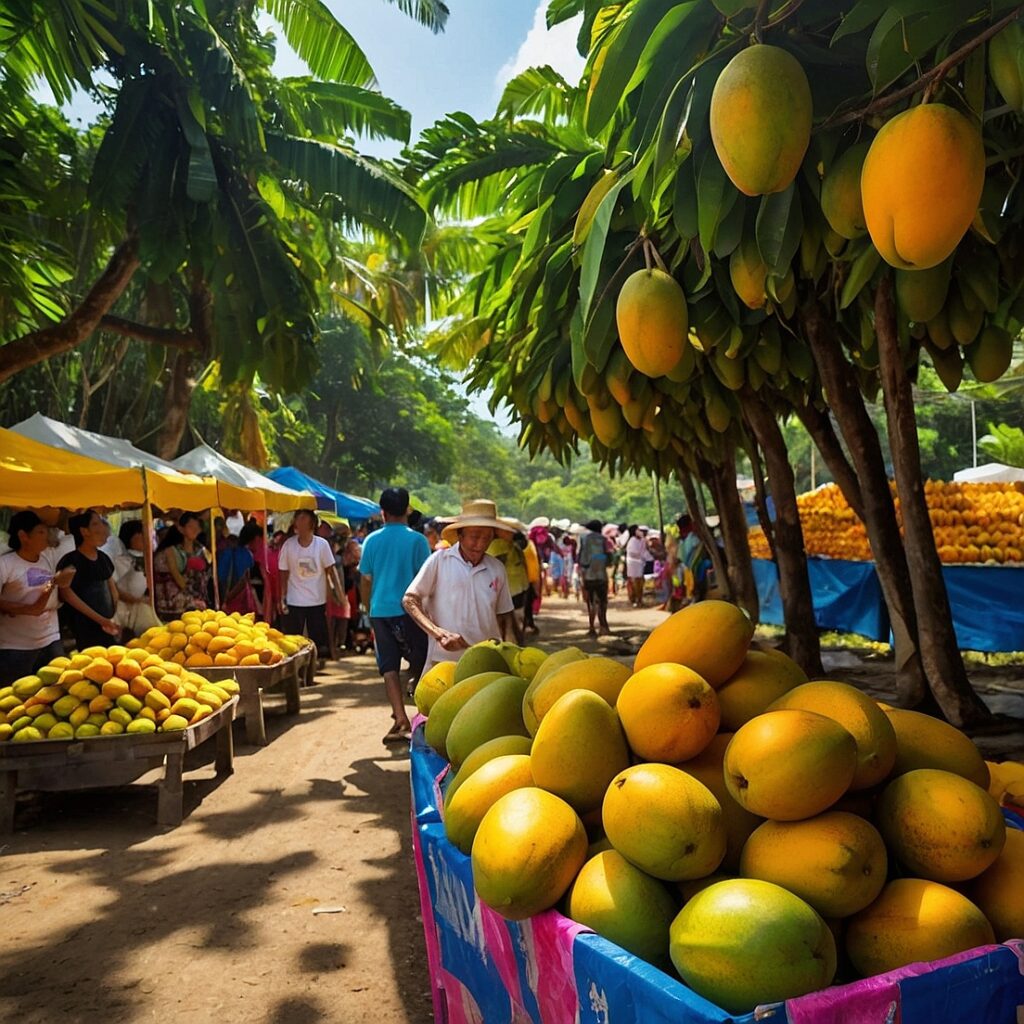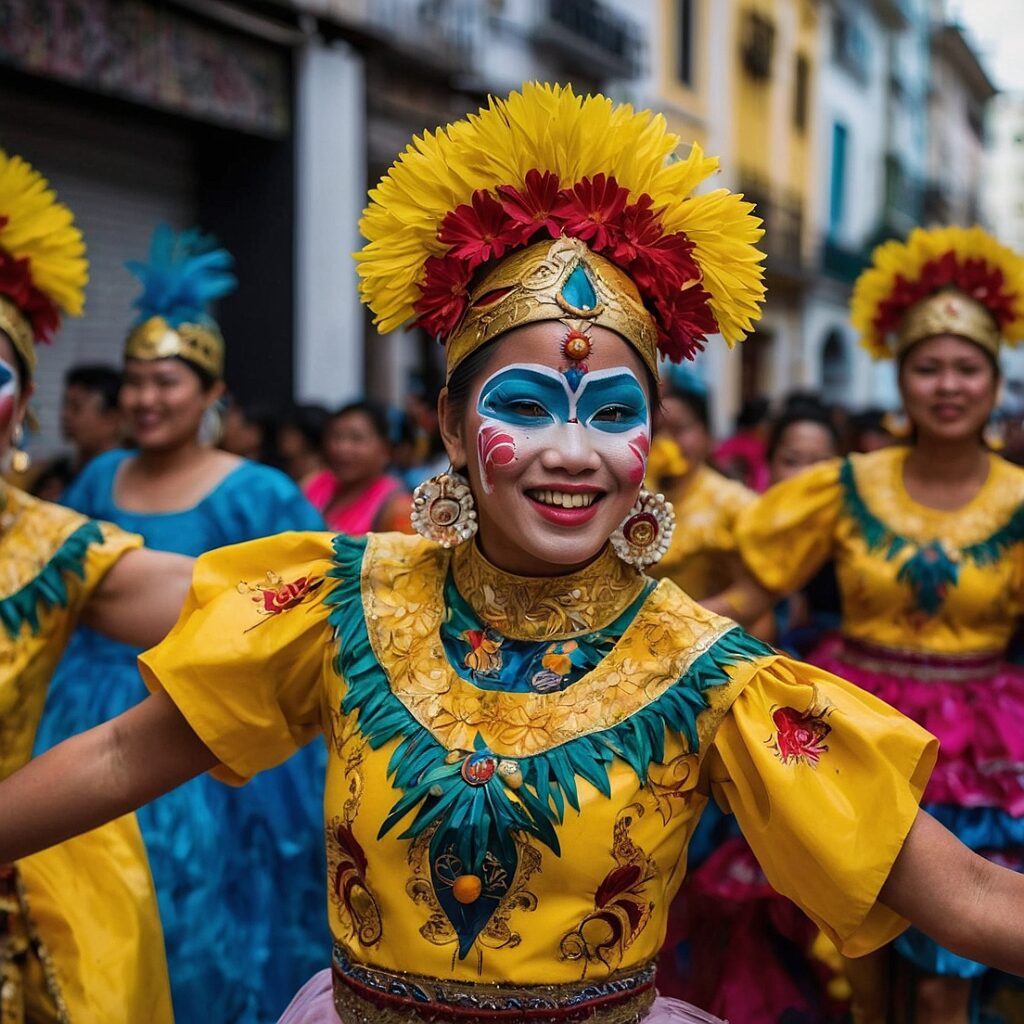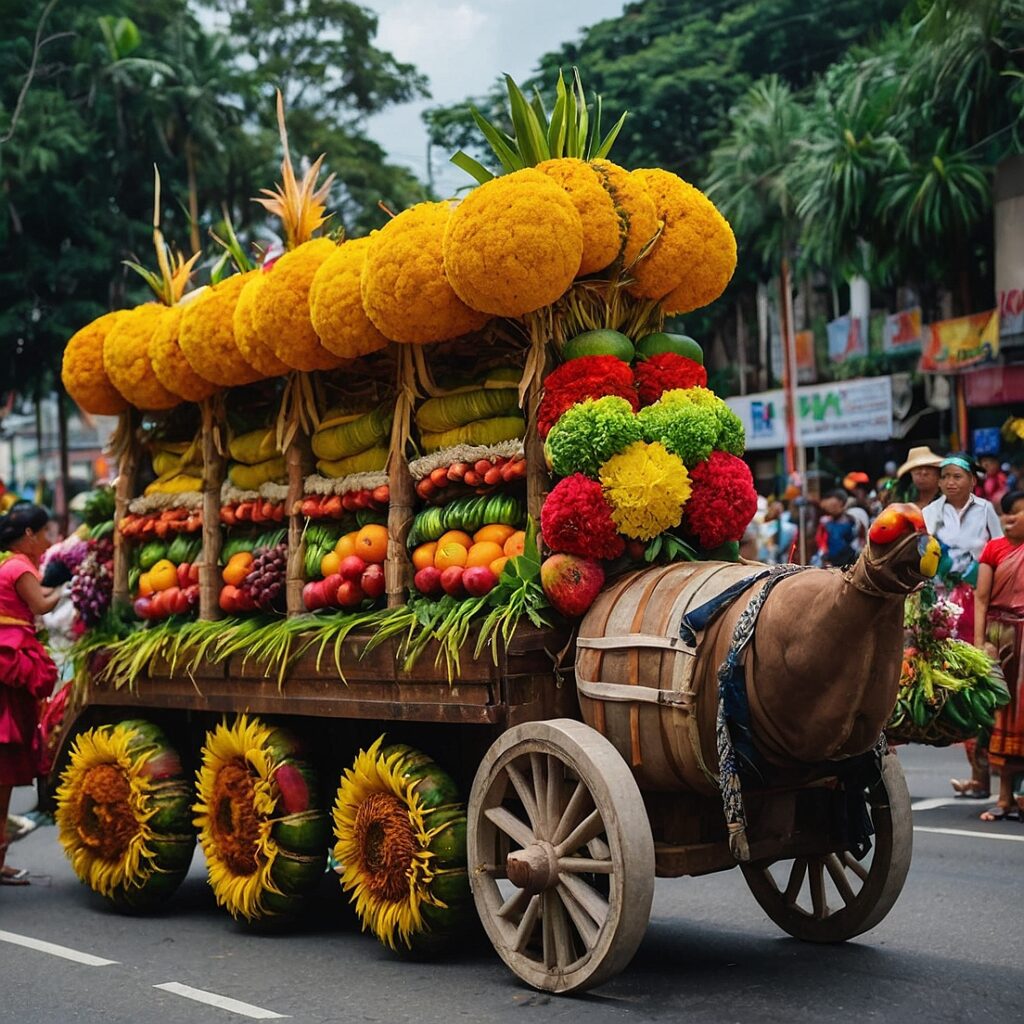Welcome, mango lovers and adventure seekers! Today, we’re taking a juicy journey to the heart of the Philippines, where the sweetest mangoes in the world are grown and celebrated with unparalleled enthusiasm. Picture this: lush green landscapes, pristine beaches, and the intoxicating aroma of ripe mangoes wafting through the air. This is Guimaras, an island province that has earned its reputation as the “Mango Capital of the Philippines.” But what makes this place truly special is not just its mangoes, but the vibrant celebration that brings together locals and tourists alike – the Manggahan Festival, or simply, the Mango Festival.
In this blog post, we’re going to dive deep into the world of Guimaras mangoes and their annual festival. We’ll explore the history, the festivities, the cultural significance, and of course, the star of the show – those irresistibly sweet mangoes. So, grab a slice of mango (or better yet, a whole fruit), and let’s embark on this mouthwatering adventure together!
The Origins of Guimaras Mangoes: A Sweet Legacy
A Fruitful History
The story of Guimaras mangoes is as rich and colorful as the fruit itself. These golden orbs of sweetness have been growing on the island for centuries, but it wasn’t until the 20th century that they gained international recognition. The unique combination of Guimaras’ fertile soil, favorable climate, and the dedication of local farmers has resulted in mangoes that are unparalleled in taste and quality.
The Rise to Fame
In the 1970s, Guimaras mangoes began to catch the attention of fruit enthusiasts beyond the Philippines. Their exceptional sweetness, smooth texture, and minimal fiber content set them apart from other mango varieties. But it was in 1995 that these mangoes truly made their mark on the world stage. The Guinness Book of World Records recognized Guimaras mangoes as the sweetest in the world, a title that the island has proudly maintained ever since.
A Protected National Treasure
Recognizing the importance of Guimaras mangoes to both the local economy and national pride, the Philippine government took steps to protect this precious fruit. In 2005, they declared Guimaras mangoes as a National Product, ensuring that only mangoes grown on the island could bear the prestigious Guimaras mango name. This protection has helped maintain the quality and reputation of the fruit, making it a true national treasure.
The Manggahan Festival: A Celebration of Sweetness
The Birth of a Tradition
The Manggahan Festival, or Mango Festival, was born out of a desire to celebrate the island’s most famous product and boost local tourism. Initiated in 1993, the festival has grown from a small local event to a major attraction that draws visitors from all over the Philippines and beyond. Typically held in May, during the peak of mango season, the festival has become a cornerstone of Guimaras’ cultural identity.
A Week of Mango Madness
The Manggahan Festival is not just a day-long affair – it’s a week-long extravaganza that transforms the entire island into a mango-themed wonderland. From parades and street dancing to mango-eating contests and culinary showcases, every aspect of the festival is designed to celebrate the beloved fruit. Let’s take a closer look at some of the highlights:
- Mango Parade: The festival kicks off with a grand parade featuring colorful floats adorned with mangoes and mango-themed decorations. Local schools, businesses, and community groups participate, creating a vibrant spectacle that sets the tone for the week ahead.
- Street Dancing Competition: One of the most anticipated events is the street dancing competition, where participants dress in mango-inspired costumes and perform choreographed dances that tell the story of Guimaras and its famous fruit.
- Mango Eating Contests: For those with a competitive spirit and a big appetite, the mango eating contests are a must-see (or participate in, if you’re feeling brave!). Contestants race to eat as many mangoes as possible in a set time, with the winner crowned the “Mango King” or “Mango Queen.”
- Agri-Tourism Booths: Local farmers and mango producers set up booths to showcase their products, offering visitors a chance to taste different mango varieties and learn about the cultivation process.
- Mango Cook-Off: Chefs from all over the region compete to create the most innovative and delicious mango-based dishes, pushing the boundaries of what’s possible with this versatile fruit.
More Than Just Mangoes
While mangoes are undoubtedly the star of the show, the Manggahan Festival has evolved to encompass much more than just the fruit. It’s a celebration of Guimaras culture, showcasing local arts, crafts, and traditions. Visitors can enjoy:
- Cultural Performances: Traditional dances, music, and theatrical performances that highlight the rich heritage of Guimaras and the Western Visayas region.
- Art Exhibitions: Local artists display their work, often featuring mango-inspired themes or scenes from island life.
- Sports Events: From basketball tournaments to extreme sports demonstrations, there’s something for every type of sports enthusiast.
- Educational Workshops: Seminars and workshops on mango cultivation, sustainable farming practices, and the economic importance of the mango industry to Guimaras.
The Economic Impact: How Mangoes Shape Guimaras
A Fruitful Economy
The mango industry is more than just a source of pride for Guimaras – it’s a significant economic driver for the island province. Let’s look at some numbers to understand the impact:
| Year | Mango Production (Metric Tons) | Export Value (Million PHP) | Employment in Mango Industry |
|---|---|---|---|
| 2017 | 11,568 | 45.6 | 4,500 |
| 2018 | 12,034 | 52.3 | 4,800 |
| 2019 | 12,756 | 58.7 | 5,100 |
| 2020 | 11,982 | 49.2 | 4,900 |
| 2021 | 12,543 | 55.8 | 5,200 |
As we can see from the table, despite some fluctuations (likely due to factors like weather conditions and the global pandemic), the mango industry in Guimaras has shown resilience and growth over the years. The industry not only provides direct employment to thousands of locals but also supports various ancillary businesses such as transportation, packaging, and tourism.
Tourism Boost
The Manggahan Festival plays a crucial role in boosting tourism in Guimaras. During the festival week, the island sees a significant influx of visitors, with hotels and resorts often fully booked months in advance. This surge in tourism has several positive effects:
- Job Creation: The festival creates temporary jobs in event management, hospitality, and various service industries.
- Local Business Growth: Restaurants, souvenir shops, and other local businesses see increased sales during the festival period.
- Infrastructure Development: To accommodate the growing number of visitors, there has been continuous improvement in the island’s infrastructure, including roads, ports, and public facilities.
The Mango’s Journey: From Tree to Table
Cultivation: The Art of Growing Sweetness
Growing the world’s sweetest mangoes is no small feat. It requires a combination of ideal natural conditions and expert care from dedicated farmers. Here’s a glimpse into the cultivation process:
- Soil Preparation: Guimaras’ soil is naturally rich in minerals, but farmers still take great care in preparing the land for mango trees, ensuring proper drainage and nutrient content.
- Planting: Mango trees are typically planted during the rainy season to ensure they have enough water to establish strong roots.
- Care and Maintenance: Regular pruning, pest control, and fertilization are essential to maintain healthy trees and high-quality fruit.
- Flowering and Fruit Development: Farmers use various techniques to induce flowering at the right time, ensuring a good harvest during peak season.
- Harvesting: Mangoes are carefully hand-picked to avoid bruising, with farmers selecting only the best fruits for sale.
From Farm to Market
Once harvested, Guimaras mangoes embark on a journey that can take them across the Philippines and even around the world. Here’s how it typically unfolds:
- Sorting and Grading: Mangoes are sorted based on size, color, and quality. Only the best make it to the export market.
- Packaging: Carefully wrapped to prevent damage, the mangoes are packed in boxes designed to maintain optimal temperature and humidity.
- Transportation: Depending on the destination, mangoes may be transported by boat, plane, or refrigerated trucks to ensure they reach consumers at peak freshness.
- Quality Control: At various points in the journey, the mangoes undergo quality checks to ensure they meet the high standards associated with the Guimaras name.
- Distribution: Finally, the mangoes reach markets, supermarkets, and specialty stores, ready to delight mango lovers with their exceptional sweetness.
Beyond the Festival: Mango-Inspired Tourism
Year-Round Mango Adventures
While the Manggahan Festival is undoubtedly the highlight of the mango calendar in Guimaras, the island offers mango-themed experiences throughout the year. Visitors can enjoy:
- Mango Farm Tours: Many local farms offer tours where visitors can learn about mango cultivation, pick their own mangoes, and even adopt a mango tree.
- Mango Processing Plant Visits: See how mangoes are transformed into various products like dried mangoes, mango jams, and mango juices.
- Mango-Themed Restaurants: Several eateries on the island specialize in mango-based dishes, from savory mango curries to sweet mango desserts.
- Mango Spa Treatments: Some resorts offer spa treatments using mango-based products, promising to nourish both body and soul.
Eco-Tourism and Sustainability
The success of the mango industry has led to increased awareness about sustainable farming practices and environmental conservation in Guimaras. Many mango farmers are adopting organic farming methods, and there are ongoing efforts to preserve the island’s natural beauty while promoting responsible tourism.
The Cultural Significance: Mangoes in Guimaras Tradition
A Symbol of Identity
For the people of Guimaras, mangoes are more than just a fruit or an economic resource – they’re a symbol of cultural identity. The mango has found its way into local art, music, and even folklore. Many Guimaras natives take great pride in their mango heritage, seeing it as a representation of their island’s unique character and the hard work of generations of farmers.
Mango in Festivities and Rituals
Beyond the Manggahan Festival, mangoes play a role in various local traditions and celebrations:
- Weddings: It’s not uncommon to see mango-themed decorations at Guimaras weddings, symbolizing sweetness and prosperity for the newlyweds.
- Religious Celebrations: During certain religious festivals, mango leaves and fruits are used as decorations in churches and processions.
- Coming of Age Ceremonies: Some families incorporate mangoes into traditional coming-of-age rituals, representing the sweetness of life and the ripening of youth.
Challenges and Future Prospects
Facing Climate Change
Like many agricultural products worldwide, Guimaras mangoes face challenges from climate change. Unpredictable weather patterns, increased frequency of storms, and changing temperatures can affect mango yields and quality. However, local farmers and agricultural experts are working on adaptive strategies to ensure the sustainability of mango production:
- Developing more resilient mango varieties
- Implementing water conservation techniques
- Using advanced weather forecasting to optimize farming practices
Market Competition
As the global demand for mangoes increases, Guimaras faces competition from other mango-producing regions. To maintain its edge, the province is focusing on:
- Strengthening its brand as the home of the world’s sweetest mangoes
- Diversifying mango products (e.g., organic mangoes, value-added products)
- Exploring new export markets while maintaining strong quality control
The Future of the Manggahan Festival
Looking ahead, the organizers of the Manggahan Festival are exploring ways to make the event more sustainable and globally appealing:
- Incorporating more eco-friendly practices in festival operations
- Expanding digital presence to reach a wider audience
- Collaborating with international culinary experts to showcase Guimaras mangoes on the world stage
A Sweet Legacy Continues
As we wrap up our journey through the world of Guimaras mangoes and the Manggahan Festival, it’s clear that this small island province has created something truly special. From the dedicated farmers tending their orchards to the enthusiastic festival-goers celebrating in the streets, the love for mangoes runs deep in Guimaras.
The Manggahan Festival is more than just a week-long party – it’s a testament to the power of community, tradition, and a really good fruit. It showcases how a local product can become a source of pride, economic growth, and cultural identity for an entire region.
So, whether you’re a die-hard mango fan or just someone looking for a unique travel experience, consider adding Guimaras and its Manggahan Festival to your bucket list. Trust me, once you’ve tasted the world’s sweetest mangoes and experienced the warmth of Guimaras hospitality, you’ll understand why this little island has captured the hearts (and taste buds) of people around the world.
And who knows? Maybe next year, you’ll find yourself dancing in a mango-themed parade, competing in a mango-eating contest, or simply lounging on a beautiful Guimaras beach, savoring the unparalleled sweetness of a perfectly ripe mango. After all, in Guimaras, every bite is a celebration!
Disclaimer: The information in this blog post is based on data and events up to 2021. While we strive for accuracy, some details may have changed since then. We encourage readers to verify current information about the Manggahan Festival and Guimaras mangoes from official sources. If you notice any inaccuracies, please report them so we can promptly make corrections. Thank you for your understanding and enjoy your mango adventure!




